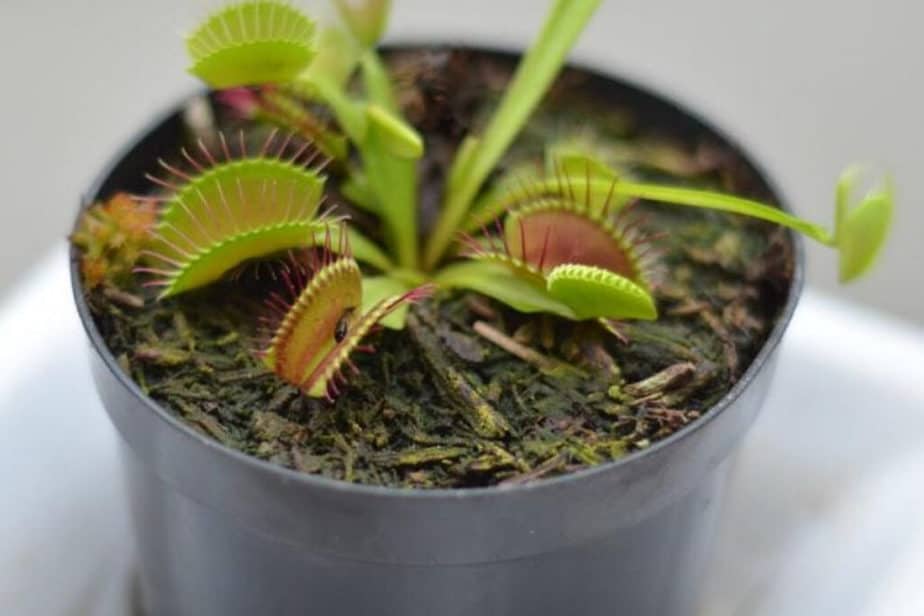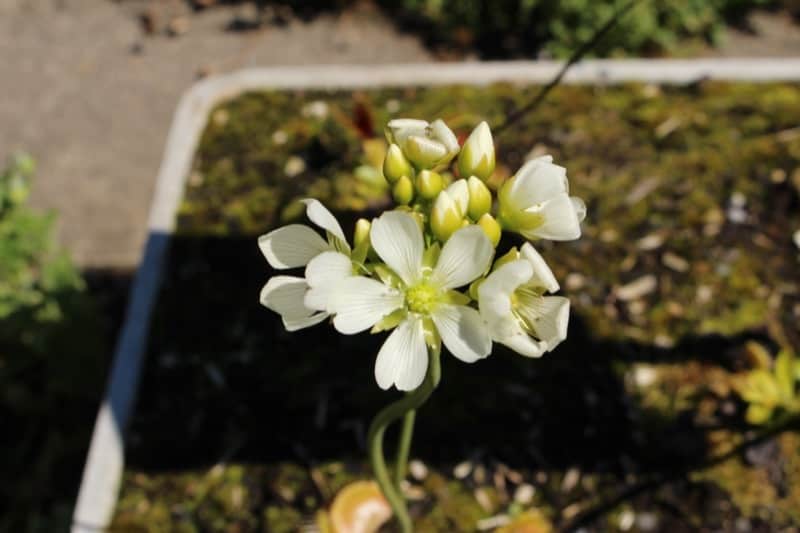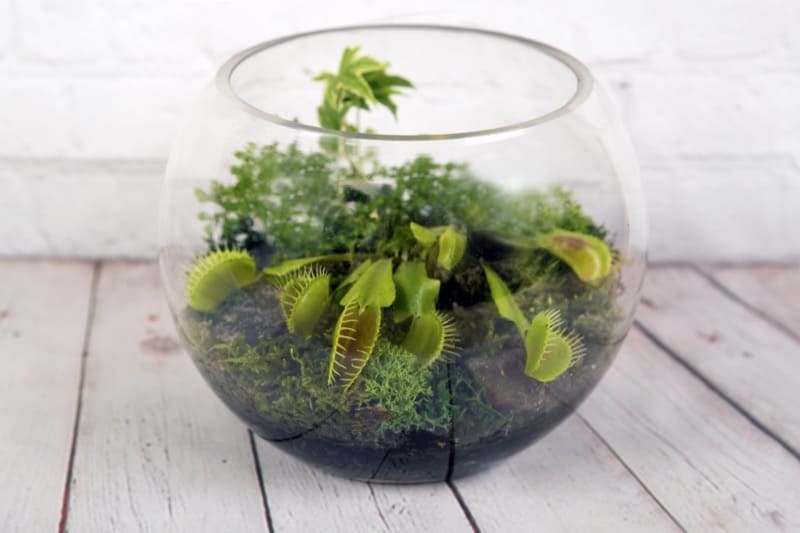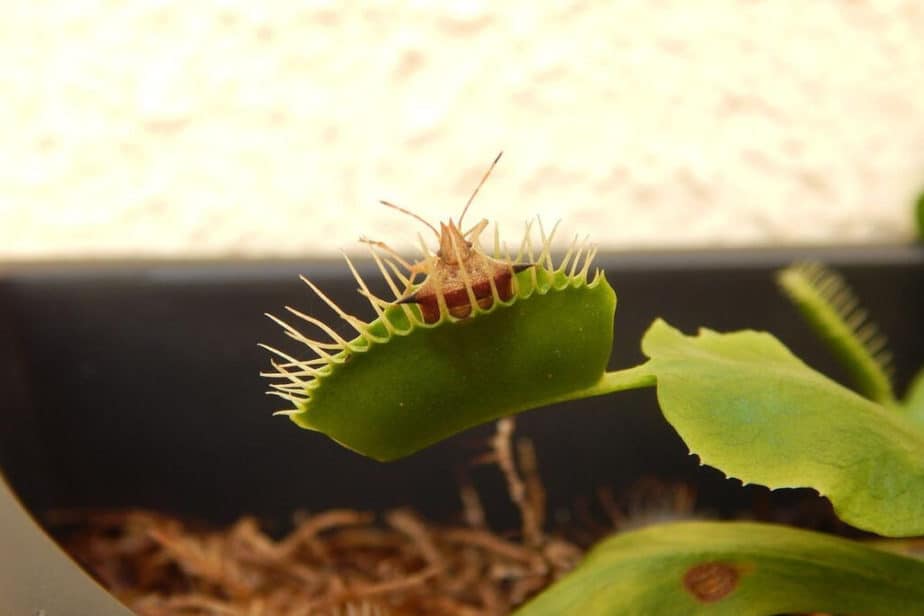Venus Flytraps are carnivorous plants native to the East Coast in North America. These plants are extremely popular among gardeners and nature lovers.
Venus Flytraps are known for trapping insects inside their “flytraps.” The plant uses its leaves to capture prey and then digests it using enzymes secreted by glands located at the base of the leaf.
The Venus flytrap is often reported to be difficult to grow indoors, but by understanding its specific needs, it can be successfully cultivated.
They do require conditions that are different than other popular houseplants, but Venus fly trap care indoors is not too difficult.
- Related: Guides for Houseplants
This guide will teach you how to care for Venus Flytrap indoors successfully.

Venus Flytrap Plant Overview
The Venus Flytrap belongs to the Droseraceae family, the Dionaea muscipula, is indeed a unique creature within the plant world. Not only is it unique in appearance, but its feeding habits are also quite out of the ordinary.
The Venus flytrap eats flies and other garden insects. They grow better outdoors where there’s an abundance of insect snacks for them. When growing indoors, you may need to catch insects yourself to feed them.
The Venus flytrap is native to the North Carolina and South Carolina coasts. That’s the only areas where the Venus flytrap will grow naturally. Environmental destruction has placed its survival at risk though, and it is thought to already be extinct in several native areas.
While some horticulturalists have attempted to cultivate the plant in new areas, this is not a recommended practice as it may upset already established ecological bio-systems.
This plant is characterized by its “flytrap” which is actually a leaf. They grow as many as eight of these traps. Most varieties of the plant will grow to only one to two inches tall and wide. While it is not the only plant with a modified leaf, it is singled out for its carnivorous nature.
This leaf features two lobes that resemble lips united by a natural “hinge”. Inside the lobes, nectar is produced that acts as bait to attract insects to visit. When an insect enters, it will inevitably touch the trigger hairs that will spring the trap shut.
The visiting, unsuspecting insect will remain trapped within a prison-like cage formed by the leaf with its interlocking teeth. As the insect struggles to free itself, the trap will seal itself, and enzymes used in digestion will attack and dissolve the trapped insect’s soft tissue.
Depending on the insect, it will be digested in four to ten days. The plant will absorb the liquid nutrients from the insect, leaving its carcass to attract other insects when it reopens its jaws.
Venus Flytraps will also flower once a year with beautiful white petals. But these Venus Flytrap Flowers will use energy to bloom, rather than to grow the plant and traps themselves. More on this below.

Venus Flytrap Varieties
The Venus flytrap’s botanical name is the Dionaea muscipula. The name of the genus Dionaea means “daughter of Dione,” in reference to the Greek goddess Aphrodite.
The name of the species “muscipula” translates to mousetrap in Latin. “Venus” refers to the Roman goddess of love that was associated with gardens and cultivated fields as well as beauty, love, desire, prosperity, sex, and fertility.
There is only a single species of this plant. But many cultivars have developed by breeders and they boast quite original Venus fly trap names such as:
- Dionaea “DC All Red” – Many cultivars are distinguished primarily due to color. Some will be completely green, others will be partially green, and still, others will have some purple, red, or yellow. The “DC All Red” is in fact, completely red.
- Dionaea “Flaming Lips” – A Venus flytrap with bright orange traps.
- Dionaea “Ginormous” – This is perhaps the largest of Venus Flytraps with the plant’s traps measuring a generous 2.25 inches across its opening.
- Dionaea “Justina Davis” – An entirely green variety of the Venus flytrap
- Dionaea “Petite Dragon” – As its name indicates, it is one of the tiniest Venus Flytraps with the actual trap measuring no more than one-half-inch across.
- Dionaea “Purple Haze” – due to its traps having a deep purple color.
- “Dente” or “Dentate” – A cultivar named for its short, serrated teeth that resemble the dentition of a shark rather than the long lashes of the typical Venus flytrap.
- “B52” Giant – One of the largest Venus flytrap cultivars, capable of producing traps over 2 inches in length. It’s named after the B52 bomber, reflecting its large size.
- “Red Dragon” or “Akai Ryu” – This cultivar is notable for its striking all-red coloration, unlike the typical green and red of most Venus flytraps.
- “Royal Red” – Similar to ‘Red Dragon’, but retains some green coloration on the plant.
- “Big Mouth” – A cultivar that produces large traps and exhibits vigorous growth.
Read more about the Red Variety of Venus Flytraps.
Venus Fly Trap Indoor Care Guide
Most home gardeners will cultivate their Venus in a container inside their home as opposed to cultivating it outdoors in a garden. A Venus fly trap indoor setup does, however, have specific needs that tie into the plant’s natural habitat.
In the wild, Venus flytraps grow naturally in “bogs”. A bog habitat will be sunny with soil that is poor in nutrition, but acidic and wet. Even though bog soil doesn’t have much in the way of nutrients, these plants still get their nutrients, from their insect prey.
Soil Requirements for the Venus Flytrap
Venus prefers more acidic soil than most common houseplants. These plants should not be grown in regular potting soil or garden soil.
By using peat moss in equal measure with horticultural sand, the soil bed should be adequately acidic.
Other mix alternatives include one part of perlite to two parts peat moss, an equal blend of perlite and peat moss, or long-fiber sphagnum that is of high quality.
Learn more about the Best Venus Flytrap Soil.
Temperature for the Venus Flytrap
The Venus flytrap enjoys temperatures from 70° to 95° F as an outdoor plant and they do great in the summer heat. Average indoor temperatures are good for these plants.
Ideal temperatures during the 3-4 months of winter dormancy will range from 35° to 50° Fahrenheit. If they’re planted outdoors as a potted plant, they are able to survive temperatures as low as 20° F during the winter months, but not for longer than a couple days. Cover them up to protect them from freezing.
Light for the Venus Flytrap
Ideally, Venus should be located in a window or spot where it will receive approximately twelve hours of daily bright, indirect light. Direct sunlight for 4-6 hours a day is good for it.
The Flytrap will go dormant in the fall when there are shorter daylight hours. It may lose its leaves and appear as if it is dying, but it’s not. It continues to live underneath the soil thanks to its rhizomes.
There’s no need to supplement the light with artificial light. Its normal environment with reduced sunlight should be maintained.
If you grow the plant outdoors, it will require four or more hours of sunlight that is direct, and two to four hours of indirect sunlight.
Learn more in this in-depth guide to Light for Your Venus Flytrap.
Water and Humidity for the Venus Flytrap
This plant will want more water than the other container plants in your home garden. It should be given rainwater as opposed to tap water. Tap water may contain chlorine, fluoride or other minerals, depending on where you live.
If possible, set up a good-sized container outdoors such as a rain barrel to collect rainwater for this plant. If this is not possible, distilled water can be used. The Venus flytrap will not appreciate water with salts, chlorine, or minerals.
As a bog plant, the soil should remain medium moist to wet. The soil bed should not be allowed to dry out. One sure way to water correctly is to set the plant in a saucer of water for several hours every few days. During its winter dormancy period, beginning in autumn, watering should be reduced.
Check out the more in-depth article on How to Water a Venus Flytrap.
Venus Flytraps can be grown indoors in open terrariums which will assist with humidity. Humidity should not be high, but just over 50%. They should never be cultivated in closed terrariums, as rot may develop.
Terrariums should never be used outdoors because the glass will amplify the strength of the sunlight potentially burning leaves.

Feeding the Venus Flytrap
Fertilizing the Venus fly trap plant will be counterproductive, so it is advisable to avoid using a fertilizer with this plant. It will most likely kill the plant. You will, however, still need to feed your Venus flytrap. One to two bugs a month for each trap should meet the dietary needs of your Venus.
Some insects will be caught directly by the plant, but it may not catch enough when indoors. You will want to catch and feed it flies, gnats, and mosquitoes that are preferably still alive.
Once you have caught the insect, it can be placed inside its trap with a pair of terrarium tweezers. When you insert the insect into the trap, be sure to touch a trigger hair inside, so that the jaws of the plant close.
You should keep an ongoing list of the plant’s traps and when you feed them. Each trap can open and close its trap a number of times in its life, before it dies and then falls off.
There’s no need to feed the plant during the dormancy period.
Learn about the Best Food Options for Venus Flytraps.

How to Prune the Venus Flytrap
Pruning a Venus flytrap? It’s a simple, yet crucial task.
Focus on the black, dead traps. Black fly traps have served their purpose and now sap the plant’s energy. Use clean, sharp scissors to snip them off at the base.
The plant’s dormant in winter? Expect a die-back. This is natural. Gently remove the blackened parts to keep the plant tidy and healthy.
Avoid cutting the green, living traps. They’re the plant’s lifeblood, its means of catching prey and photosynthesizing.
Remember, pruning is about aiding the plant’s health. Done right, it helps your Venus flytrap channel energy into growth and capturing prey. It’s a small effort for a big reward.
- Related article: How Big Venus Flytraps Get
How to Repot Venus Fly Trap
Repotting a Venus flytrap? It’s a delicate task, but one within your grasp.
Repotting the Venus flytrap every 1-2 years into a pot that’s one size larger will allow it to continue growing healthily. The best conditions to repot is in the early spring.
Timing is essential. Early spring, as the plant emerges from winter dormancy, is ideal. It’s when the plant is preparing for new growth.
Choosing the right soil is paramount. A mix of sphagnum peat moss and perlite or sand is recommended. Avoid fertilized potting soil, as these plants thrive in nutrient-poor conditions.
The pot matters too. Choose one with good drainage. This ensures excess water doesn’t pool, which could cause root rot.
When removing the plant, be gentle. Disturb the roots as little as possible. Place it in the new pot, covering the roots with the soil mixture.
Watering is crucial post-transplant. Use distilled or rainwater, not tap. Keep the soil moist but not soggy.
Remember, repotting can stress the plant. Give it time to adjust. The rewards? A healthy, vibrant Venus flytrap in its new home.
How to Propagate a Venus Flytrap
Propagating a Venus flytrap? It’s a rewarding endeavor.
There are two main methods: division and leaf cuttings.
For division, choose a mature plant. Early spring is the best time. Gently remove the plant from its pot and separate a ‘pup’ from the mother plant. Replant both immediately in appropriate soil.
Leaf cuttings are a bit more complex. Cut a healthy leaf from the plant, leaving a bit of the white base. Plant this in a peat moss and sand mix. Keep it humid and under bright light, but not direct sun. A new plantlet should emerge in a few weeks.
Patience is key here. Venus flytraps grow slowly. It may take several years for a new plant to reach maturity.
Remember, propagation is an act of nurture. Treat your plants gently, provide them with the right conditions, and you’ll be rewarded with new Venus flytraps to enjoy.
If you do not intend to propagate your Venus Flytrap with seeds, you should remove the flower when the plant begins to bloom. That will allow for stronger, larger traps to grow.
Flowering will create seed production and divert energy that the plant can otherwise use. The Venus flytrap is not known or cultivated for floral beauty, but rather for its carnivorous nature.
- Related article: Growing a Venus Flytrap From Seed
How to Grow Venus Fly Trap Outdoors
Growing a Venus flytrap outdoors? It’s an adventure in botany.
Location is key. Venus flytraps crave full sun. Ideally, they should bask in 4-6 hours of direct sunlight daily.
Soil selection matters. Opt for nutrient-poor, well-draining soil. A sphagnum peat moss and sand mix works well.
Watering is crucial. Use distilled or rainwater. Tap water often contains minerals that can harm the plant. Keep the soil constantly moist but not waterlogged.
Temperature is important too. Venus flytraps thrive in warm, humid climates. They can tolerate a range of temperatures, but prefer between 70 to 95° Fahrenheit during the day and around 60° at night.
Winter dormancy is a natural cycle. In winter, the plant’s growth slows. Don’t be alarmed. It’s a period of rest and rejuvenation.
Avoid fertilizers. Venus flytraps derive nutrients from their insect prey, not from the soil. Fertilizers can harm them.
Remember, these plants are native to the Carolinas’ boggy areas. Recreate their natural habitat as closely as possible. With care and patience, your Venus flytrap will thrive.
Venus Flytrap Common Pests, Diseases, and Problems
Venus fly trap problems won’t be a big problem if you learn how to care for Venus fly traps.
While bugs will suffer more than the Venus flytrap, it is nonetheless subject to problems from aphids and fungus gnats. As these pests are much too small for the plant to eat, they can bother your plant.
In the fall, the Venus flytrap will slowly enter its dormant period. Leaves will most likely turn black and die. When some traps remain open and are unable to close, you will know that your plant is entering its dormant period. This period will last anywhere from three to four months.
- Related guide: Venus Flytrap Dormancy
Remember that the plant is not dead. Dropping temperatures and shorter days will trigger dormancy. The plant can be placed in a cool, unheated spot during this period, such as a basement or garage. It will not require much light but can be near a window.
When temperatures lift into the 50s, cut off any dead leaves and move the Venus flytrap to a sunny location.
Venus Flytrap Toxicity and Pets
The Venus Flytrap is not toxic to pets, or people. It can be grown without problems in a family with children, cats or dogs.
The jaws of the plant are not strong enough to harm humans, but still not a good idea to place your finger in the trap. Not because it will harm you, but rather because you will be depleting the plant’s energy. Energy that’s needed for its primary activity of catching insects.
Venus Flytrap Care Final Thoughts
In their native habitat, these plants can grow to be quite old. Unfortunately, when cultivated, they are often short-lived, because they are not cared for correctly.
Learning how to care for Venus fly trap indoors or outdoors will give you a unique addition to your home garden.
More Venus fly trap care guide articles and other houseplants that are popular to grow indoors:
- Signs of an Unhealthy Venus Flytrap
- Venus Flytraps and Mealworms
- Pitcher Plant Care Guide (Carnivorous)
- Philodendron Plant Care Guide
- Prayer Plant Care Guide
- Angel Wing Begonia Care Guide
Venus Flytrap Plant Care FAQs
Can a Venus Flytrap kill you?
No, a Venus Flytrap can’t kill you as it’s not poisonous and its “teeth” are not sharp. They only have two sets of lips on each side of their mouth with filaments that look like the “teeth.” These lips are used to capture prey. If an insect gets caught between them, then the Venus Flytrap closes around the bug and kills it.
Can a Venus Fly Trap survive without bugs?
No, a Venus Flytrap needs bugs to live. Without bugs, there would be no food source for the plant. Bugs provide nutrients to the plant so that it can thrive. If you are growing the bug-eating plant indoors, you may need to catch insects yourself to feed the plant.
Do you have to feed each Venus Flytrap?
Yes, you have to feed insects to the Venus Flytrap if you want healthy growth. You should water the soil regularly and feed it insects if it’s not catching enough insects itself.
Why are Venus Flytraps so hard to keep alive?
Venus Flytraps are hard to keep alive mostly due to improper watering and feeding habits. Most people don’t realize how important proper nutrition is to keeping a Venus Flytrap alive. A well-fed plant will produce many new traps every year.
Is it easy to take care of a Venus Flytrap?
The ease of how to take care of a Venus Fly trap depends on what kind of environment you’re going to grow it in. Some types of environments make it easier than others. Venus Flytrap plants do better outdoors because of more sunlight and insects to feed on.
Can you overfeed a Venus Fly Trap?
Feeding a Venus flytrap is a delicate dance. Overfeeding fly traps can cause harm and even physical damage. Traps may blacken, wilt, and eventually die.
These green marvels draw their primary sustenance from the sun. Insects are a bonus, not a necessity.
Too many insect meals can strain the plant. Each meal requires energy for digestion. More meals? More stress.
So, how much is too much? Aim for one insect per trap each month. This safeguards against overindulgence.
Remember, a Venus flytrap’s wellbeing hinges on moderation. Overfeeding? It’s a pitfall best avoided.
How long can a Venus Flytrap live?
The Venus Flytrap can live for up to 30 years if properly maintained. If left alone, it may only live 10–15 years. The traps on the plant don’t survive too long as they will die after opening and closing a few times. The dead traps will fall off and be replaced by a new trap.


